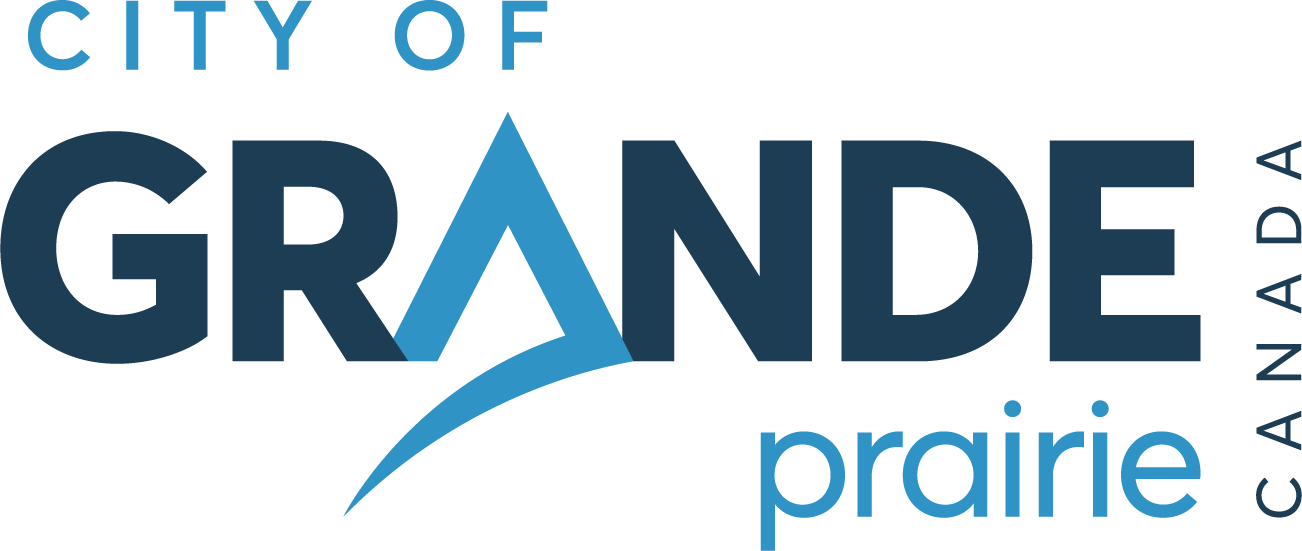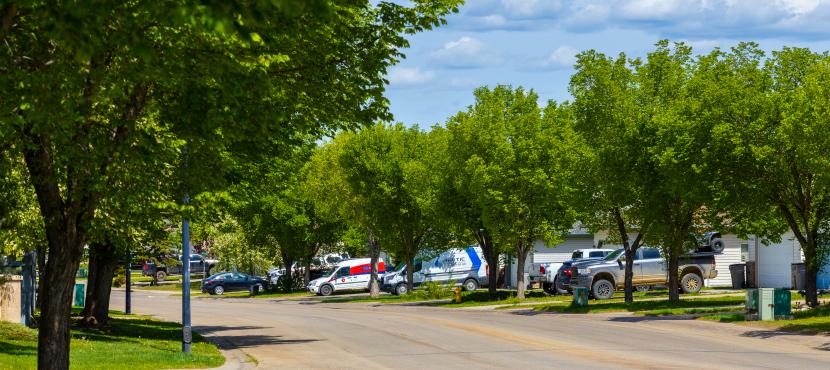The City of Grande Prairie owns a strip of land along the front of every titled property, usually for the purposes of utility location. This is called a boulevard. Residential boulevards are ideal sites to plant city trees, since they have been shown to survive and grow better than trees in parks or along major roadways. Boulevard width varies depending on where in the city your property lies, so it's worth confirming before you start any projects.
Learn more about Boulevard Trees and our Urban Forest here.
You can see an example of different residential boulevard widths in a typical neighbourhood and the city-owned trees (red arrows) in the picture provided.
- The blue-arrowed trees are within the parcel boundaries of the homeowner and the homeowner may prune, remove or replace them as they wish.
- The red-arrowed trees, however, are owned by the city and are part of our tree inventory. Any pruning, removal or replacement must be assessed and decided by the city, not the homeowner.
This diagram also clearly illustrates how boulevard widths can change within a short span of distance. Within the space of one block, the grassed residential boulevard in front of these homes decreases from 5 meters (at point A) through 2.8 meters (point C) down to 1.3 meters (point B).
CALL don't CUT! Please double check your residential boulevard width before commencing any tree planting, removal or modification in your front yard!
There are many concrete benefits to having a healthy boulevard tree in front of your home, such as:
- Providing shade for vehicles and homes
- Increasing property values on your home and in your neighbourhood
- Providing habitat and food to wildlife, birds and humans
- Absorbing air pollution and blocking dust and wind
Residential boulevard trees are usually healthier and live longer than trees in parks and along roads. This is typically because of the extra water and nutrition they receive from the homeowner's landscape care. Parks Operations thanks homeowners for helping to grow Grande Prairie’s urban forest!
Parks Operations asks that homeowners do not interfere with their boulevard tree with regards to any pruning, spraying, fertilizing or removal operations as per Section 22 of Bylaw C-504 (PDF, 31 KB).
However, during dry spells these trees benefit greatly from supplemental watering. If no significant rain has fallen in the past month, turning your garden hose to a trickle and letting it soak the ground for one hour in a few different places over the tree's root zone will help it continue to grow and thrive.
Directing your downspout or sump pump hose at the root zone of the tree is another option to provide extra water. However, in these situations the tree must be monitored closely during rainy spells to ensure it doesn't drown.
Many homeowners like to plant flowerbeds around their trees, which usually helps with supplemental watering. However, piling soil or mulch against the trunk of a tree can eventually cause rot and decay, so we ask you to please pull extra soil or mulch back so they are not laying directly against your tree's trunk.
Call don't cut! The best thing a homeowner can do for their trees is to call the Citizen Contact Centre first if they have concerns about the health of a boulevard tree.
More than 50 years ago maydays (Prunus padus) were planted as boulevard trees in many areas of the city. This species was chosen because it was considered to be one of the few ornamental trees that could cope with the short growing season and hard winters. Most mayday trees growing in an urban environment decline rapidly after thirty years of age. In fact, dieback may begin in as little as twenty years.
As part of our Tree Renewal program, these maydays will be replaced with a new city boulevard tree. If there is no planting conflict and the budget is available, a new tree will be planted in the fall. Planting conflicts include utility lines, existing trees, driveways, sightlines, etc.. Unfortunately, if a planting conflict exists that cannot be worked around, the tree will not be able to be replaced. Homeowners will be advised of tree type and planting location before work commences.

